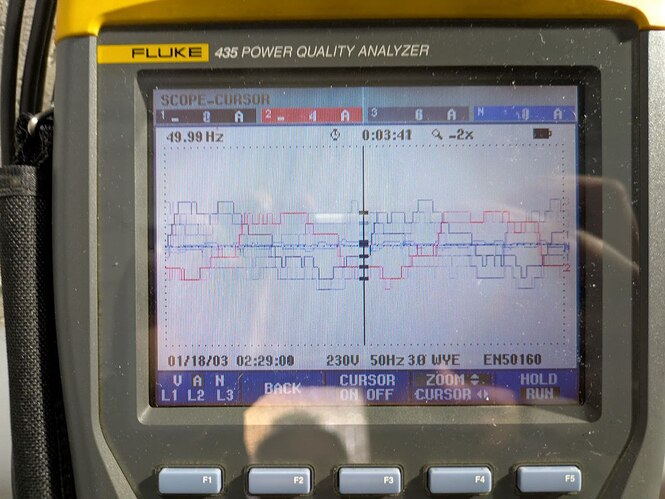Hello guys
after spending 2 full workdays together with my colleague (we are both electric engineers) with the setup of 2 Multis per Phase (so a total of 6) i would like to give a update:
so far victron is refusing any support (or at least not providing helpful information)
so we tested a lot of things. what i can say is a 20kVA Generator on the AC in does not work, no matter how the inverters are configured, we tried really everything.
the only thing that worked to charge up the batteries was removing the grid code and ESS from the configuration and connecting the generator in parallel mode to AC out.
however that is ofcorse no solution since i cannot use the batteries for self consumption anymore.
what we found out is that the battery charging behavior changes a lot as soon as a grid code is set (even if set to the Danish grid code where LOM is forbidden (no idea why))
This screenshot is charging the batteries without a grid code. as you can see, the inverter goes to a constant power and stays (almost) rock solid to the target power, even if the load is changing.
However if we take a look at this screenshot, we see that the Power is always swingig up and down (the target “ESS Setpoint” is lowered slowly over time from externaly so don’t be confused why it reduces the power from 7 to 5 kw. it is meant do do so but on a linear rate)
So the charger seems to behave even like this if there is no grid, ending up in a unstable RPM of the generator. If the Generator is on AC in, it starts to “swing” and once it reached 49.8 or 51.5 Hz it disconnects. If it is on AC out, the generator also starts to swing and trips its circuit breaker or the inverters go off because of overload.
next thing we found out was, that while the inverter is syncing on the Generator (gen on AC in) the sine wave of the generator starts to look like that: (to quote my buddy: “even a child could draw a better sine wave”) and no, the Generator is not faulty! i can power the house having a perfect sine wave with some inductive loads like Heatpump pulling 12 kW (this is measured before the inverter closes its AC In Relay)
and this is how the current “sine” wave looks like while loading the genset (Target Power was 20A but long before it reached that point it disconnected):
The oscilloscope screenshots are with no ESS, no grid code, Genset on AC in EXACTLY how victron advises to do.
I was then ready to give up grid feedback and setting up the system without ESS and having a external PLC limiting the input current and using Power assist and coded my own self consumption algorithm. Until i found out that Power assist does not work with less than 6A per inverter input.
Long story short: if no other solution comes in (hopefully it will) i will sell those inverters and look out for a competitor solution that keeps up with its promises.
I would be very thankful for any input or idea how to go around this issue. all i want is a BESS and being able to charge the batteries with the genset in a power outage (and taking a 48v charger for this really makes no sense for me)










